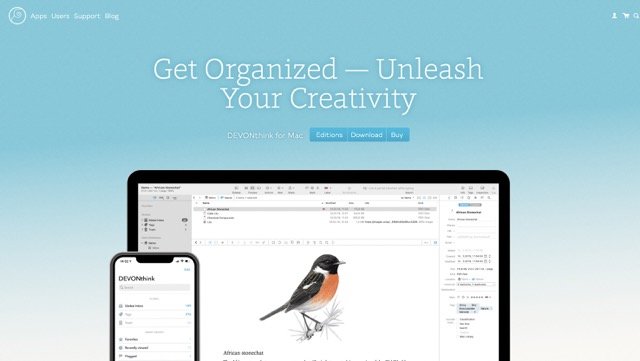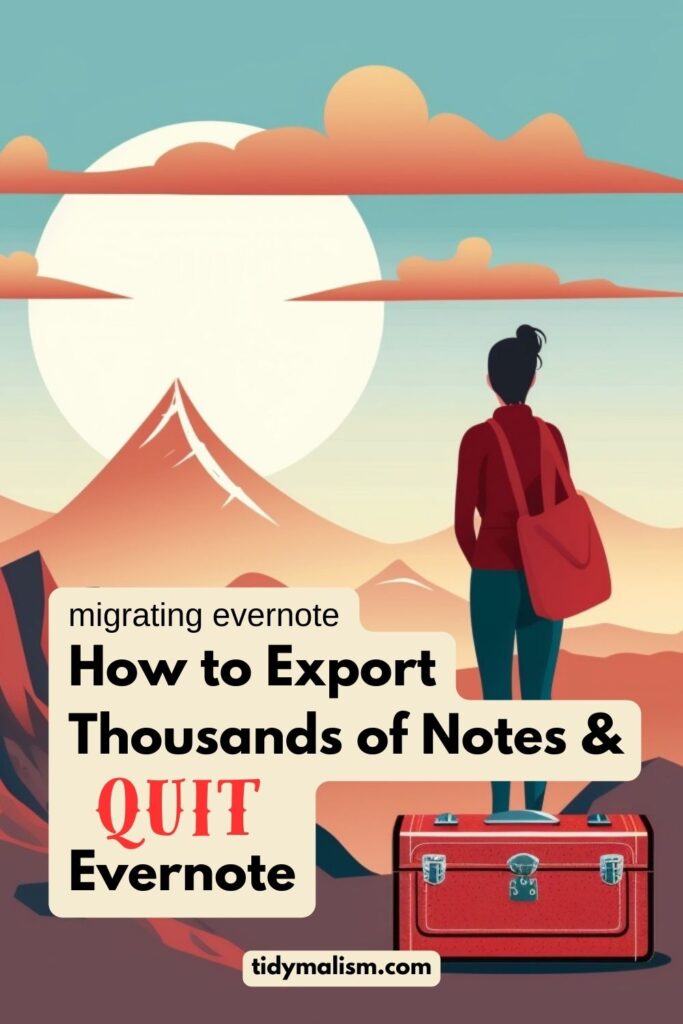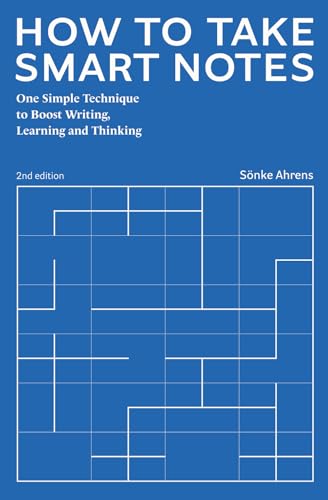Leaving Evernote can be a difficult decision, especially if you’ve grown accustomed to its note-taking and productivity features. I’ve been a hardcore Evernote user for 13 years, so cancelling my subscription was no easy decision.
In this post, I’d like to share the alternative solution I landed on in light of being an avid note-taker and productivity aficionado. I’ll also explain why I wish I had made the move sooner, and provide an overview of some of today’s most popular note-taking software.
Table of Contents
Why I’m Leaving Evernote

Since the world of note-taking and personal knowledge apps took off, Evernote has been a popular choice among users. However, concerns about privacy issues had already led a lot of users to look for alternatives in the past.
I’d been a user since 2010 and kept slugging on even though I had lost trust in the company after they introduced recommended posts that fed off of your notes. And then there was the 2016 privacy debacle.
Eventually they made you log in to access notes stored locally on your own machine. And when version 10 was released, it felt like Evernote didn’t know anymore what it was trying to be. A project management tool? A collaborative alternative to Google docs? Or a task calendar? It eventually felt like they’d lost sight of the app’s core functionality: note taking and archiving.
When v10 came out, Evernote also became painfully slow. It was markedly confusing, clunky, and the privacy issue continued to bug me. Additionally, it was hogging resources. Its killer app, the Web Clipper, took up so much of the browser’s resources that you couldn’t have much more than five tabs open in your browser at once.

What Happened to Evernote?
I started getting really frustrated with it last year, yet still went through with my Evernote certification and continued to endorse it. When Evernote was suddenly sold to the Italian company Bending Spoons in late 2022, it made me wonder if I should start looking around at my options.
The straw that broke the camel’s back for me came last month when they announced a massive price increase – nearly 100% in some cases. But with no additional functionality mind you, and without even having integrated AI in search.
“What should I use instead of Evernote?” suddenly became top of mind again, and I set off to explore my potential options. After testing a range of alternatives, I made my pick and I’m a DEVONthink user now. Altogether, I’m quite happy with my choice and wish I had quit Evernote sooner!
By the way, I am NOT an affiliate of DEVONthink, and this post was NOT sponsored. I wrote it out of pure passion.
One of the main advantages of DEVONthink is its focus on privacy and robust data storage and management. I should mention right here and now that it’s only for Apple. But there are numerous other note-taking apps on the market if you’re a Windows or Linux user. Each have their own advantages and drawbacks, so it’s important to have a clear understanding of what you want out of your note-taking app before leaving Evernote.
I Quit Evernote for DEVONthink

As a power archivist of sorts, I particularly didn’t like the way Evernote stores everything in a proprietary file format. So if I was going to make the switch and migrate 132 notebooks with over 9,000 notes across multiple stacks, I didn’t want to switch to yet another app that was going to try to lock me in.
Privacy was also a main concern, and I needed OCR functionality. I tried around ten different apps in total and some advantages of DEVONthink over Evernote included the following:
- Superior privacy: your data is in your database, so only you have access
- Your files are stored in their original formats, so you can export them easily
- Customisable interface
- Offline-first approach, so you can access your data in the absence of an Internet connection
- Seamless integration with macOS and iOS
The following table provides a comparison of Evernote and DEVONthink features that were key for me:
| Feature | Evernote | DevonThink |
|---|---|---|
| Encryption | Limited | Full |
| Privacy | Limited | Full |
| Import and Export Options | Limited | Extensive |
| Search Functionality | Advanced | Advanced |
| Platform Availability | Multiplatform | macOS and iOS |
| Price Plans | Subscription | One-time fee |
| Interface Customisation Options | Limited | Flexible |
| Optical Character Recognition (OCR) | Full | Full |
DEVONthink offers an impressive range of features, especially when it comes to security, customisation, and platform support. As a result of doing a partial test migration and playing with it for a week in trial mode, I was convinced that making the switch from Evernote was the right decision for me. I’m confident that users with similar digital minimalism goals and productivity enthusiasts can also benefit from exploring alternative solutions.
Weighing Up Other Evernote Alternatives: To Markdown or Not to Markdown?
If you’re not in the Apple ecosystem, but also want to quit Evernote, there are a number of open source and commercial options out there. However, choosing the right alternative isn’t just about finding a like-for-like replacement. So before jumping ship, take a moment to consider your specific reasons for leaving Evernote, what your use cases are, and what you want in a new app.
Key Factors to Consider When Choosing a Notes App

- Security: When you have high privacy expectations, you’ll want to assess whether your preferred alternative offers a more secure platform.
- Affordability: Check if the competitor you opt for has a pricing structure that aligns with your budget. I generally prefer to stay away from subscription-based price models wherever I can. DEVONthink, for example, has a bigger upfront ticket price, but it’s more inexpensive in the long run because you only pay once when major new upgrades are released that you actually want to use.
- Ease of use: When you just want to take straightforward notes, consider alternatives that are user-friendly and offer intuitive interactions. Apps like Bear, Microsoft OneNote, and Simplenote provide simple interfaces that streamline productivity by keeping you focused and organised.
- Open source: For some folks it’s a way of life, while others prefer to pay for the comfort of having customer support and regular updates. Go whichever route works for you. I came very close to switching to Joplin myself, which is open source. What held me back to this end was its lack of commercial development. OCR was wonky because there’s no engineering team working on it, and that was a feature high up on my list of must-haves.
- Cross-platform accessibility: Will your new software work seamlessly across multiple platforms? A cloud-based app like Notion thrives in this aspect by offering a responsive experience, whether you’re using a smartphone, tablet, or computer.
- Markdown: Markdown is a lightweight markup language that you can use to format text. In the context of note-taking apps, it basically allows you to format your notes with elements like headers, bold and italic text, lists, links, images, and more, all using plain text. For instance, you can create a header by starting a line with one or more `#` symbols, or make text bold by wrapping it with two `*` or `_` symbols. A nice feature of Markdown is that even if the formatting isn’t rendered, the text is still easily readable. This makes it a flexible option for note-taking, as it keeps your notes organised and formatted while staying compatible with a wide range of tools.
- Interoperability: You might intend to access your notes on a Windows desktop at work, your Android tablet at home, and your iPhone when you’re out and about. In this case, you’ll want to look exclusively at note taking apps that work across devices.
Focus on Your Must-Have Functions
In short, make a quick bucket list of what you’re after so you can find a good alternative. Your list could look something like this:
| If you want: | Look for: | Examples |
|---|---|---|
| Security | Superior data privacy and powerful OCR | DEVONthink |
| Affordability | Pricing structure that suits your budget | Notion, OneNote |
| Ease of use | Intuitive interface for seamless organisation | Bear, Simplenote |
| Cross-platform access | Responsive experience across multiple devices, including smartphones, tablets, PCs | Notion, Microsoft OneNote |
At any rate, your ideal Evernote alternative should offer a better balance between privacy, usability, and cost. By weighing your options carefully, you’ll thus be able to find the perfect replacement that keeps you productive and suits your workflow.

Overview of Evernote Competitors in 2025
The following table contains the most popular apps for note taking at the moment, with an overview of differences amongst their main features. I’ve tried all of them, and some were rather bad. I was most excited about Simplenote when I started testing before I realised it had no OCR. Since I had a huge PDF library in Evernote which had to be migrated, I needed it to be searchable. This meant Simplenote was not an option for me.
Apple Notes was another one I really liked. Unfortunately, there’s no cohesive way to export all your notes again if you decide to leave it one day. You actually have to submit a request with Apple to export notes (good luck finding the link to do so), and then wait a week for the export to actually happen. Um, no thanks. I didn’t want to get locked in anywhere and my notes are mine, so I should be able to export them on the spot when I want to without having to jump through hoops to do so.
Joplin and Obsidian were my other favourites out of the whole bunch. But because neither had integrated OCR, they weren’t a viable option for me. Your use case might be totally different from the systems I use though, so don’t get hung up on OCR if you don’t need it.
| App | OCR | Pricing | Syncing | Markdown | Import | Open Format |
|---|---|---|---|---|---|---|
| Simplenote | ❌ | Free | ✅ | ✅ | limited scope | ✅ |
| Obsidian | With unsupported plugin | Free for personal use, some premium features | ✅ (premium) | ✅ | limited scope | ✅ |
| Notion | ❌ | Free tier, paid tiers for more features/storage | ✅ | ✅ | ✅ | ❌ |
| Joplin | With unsupported plugin | Free and open-source | ✅ | ✅ | ✅ | ✅ |
| DEVONthink | ✅ | One-time purchase, three tiers available | ✅ | ✅ | ✅ | ✅ |
| OneNote | ✅ | Free with Microsoft Office subscription | ✅ | ❌ | limited scope | ❌ |
| Apple Notes | ✅ | Free but you need iCloud storage | ✅ | ❌ | ✅ | ❌ |
| Nimbus | ✅ (premium) | Free tier, paid tiers for more features/storage | ✅ | ✅ | ✅ | ❌ |
| Bear | ❌ | Free tier, paid for Pro features | ✅ | ✅ | ✅ | ✅ |
| Notejoy | ✅ (images) – didn’t work well when I tested | Free for up to 5 notebooks, paid tiers for more storage | ✅ | ✅ | limited scope | ❌ |
| Goodnotes | ✅ (handwriting) | One-time inexpensive purchase | ✅ | ❌ | ❌ | ❌ |
Migrating Evernote: The Big Export
Undoubtedly, one of the reasons I had been putting off leaving Evernote was that I was really dreading having to export nearly 10k notes and over one hundred notebooks!
The Evernote app had undeniably been such a huge part of my daily work flow, both at home and in home office. I even used it for blogging and keeping everything in Tidymalism’s backend organised.

When I did my first trial import into DEVONthink, however, I was put at ease. It was simple, and everything landed in the right place.
Surprisingly, even all my old tags were correctly imported. I proceeded with the migration of all nine thousand-something notes, one stack at a time just to be sure.
Not only did the entire process take me just a couple of hours one evening, but there was also some helpful advice in the DT community forum to guide me.
A few duplicates did seep in through Evernote, but they all dated back to 2010 when I had migrated from Yojimbo back then. In short, this was a pretty smooth migration.
Exporting notes from Evernote can be done through two main formats, ENEX files or HTML. One issue with Evernote to keep in mind though is its reliance on tags, which can be difficult to move to other apps.
Additionally, there’s another issue that’s more critical: you need the legacy app to export everything in one sweep from Evernote, but they recently hid it to prevent people from accessing it.
How to Go Back to the Old Version of Evernote aka Legacy App
If you use Evernote, you’re probably on version 10, which only lets you export 50 notes at a pop. This makes a migration near impossible if you have many thousands of notes like I did. The legacy app is still on their servers though. You can get to it through the Wayback Machine like I did, or see if the links in the Evernote User Forum are still online.
What Happens When You Cancel Evernote?
If you’re a subscriber and decide to cancel your paid Evernote plan, you will still have access to your account and notes, but with limitations.
Firstly, your account will revert to the free basic plan, which includes access to your notes on up to two devices. You will no longer have access to premium features such as offline access to notes, annotation of PDFs, and integration with other apps.
Your account will also be limited to a maximum of 60 megabytes of new uploads per month. Additionally, if you have exceeded the maximum amount of storage for the basic plan, you may need to delete some notes or upgrade to a paid plan again.
In short, quitting your paid Evernote subscription will result in a downgrade to the free plan, and you will lose access to a lot of features.
Cleaning Up Your System
If you started using another alternative though, there’s probably not any reason to keep Evernote at all.

Out of my nearly ten thousand notes, I deleted everything but 150 recipe notes in one notebook. I like to pull them up on my iPad Pro in the kitchen when I’m cooking, and didn’t see any harm in keeping them in the cloud.
Everything else is gone though, and I fully deleted the app from my laptops and smartphone.
A nice side effect of leaving Evernote was that so much disk space was freed up. And my browser immediately stopped crashing on an hourly basis once the Web Clipper was gone! 🥳
Other than that, I cancelled my paid plan and haven’t looked back! Overall, I’m loving DEVONthink. Creating new notes has been intuitive, it was a breeze to install and set up. Plus, I like the keyboard shortcuts, the clean UI, and the fact that I don’t have to log in anywhere with a password because everything is on my system.
I sync over Bonjour in my own network, and I particularly appreciate having control over my files and data again.
MORE ON DEVONTHINK
If you’re curious about getting started with DevonThink or just need some help while you test out the free trial version, there are a number of guides on the web:
– An Introduction to DevonThink over at AsianEfficiency
– MacSparky’s DevonThink Field Guide, a paid-for, yet affordable and very extensive course with video tutorials that many folks on Reddit have recommended
– Using DevonThink as a Zettelkasten for fans of that cataloguing method
– And don’t forget the DevonThink Community Forum, which holds a treasure trove of knowledge.
All in all, I say go for it if you’ve been on the fence about making the transition away from Evernote. I should have done it sooner, but at the same time, I’m glad I didn’t put it off any longer!















Leave a Reply